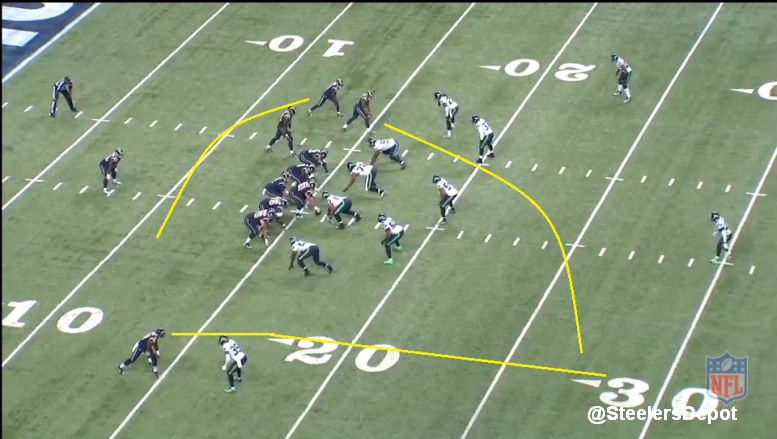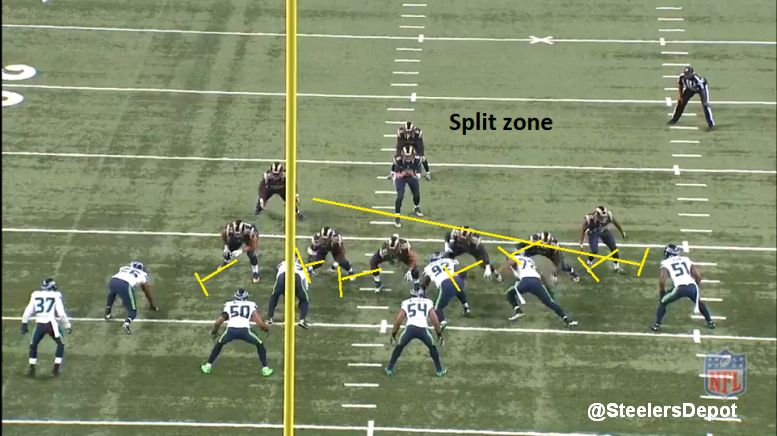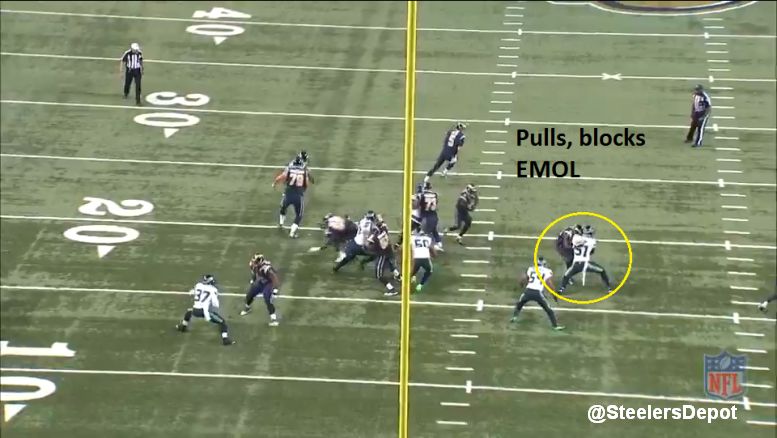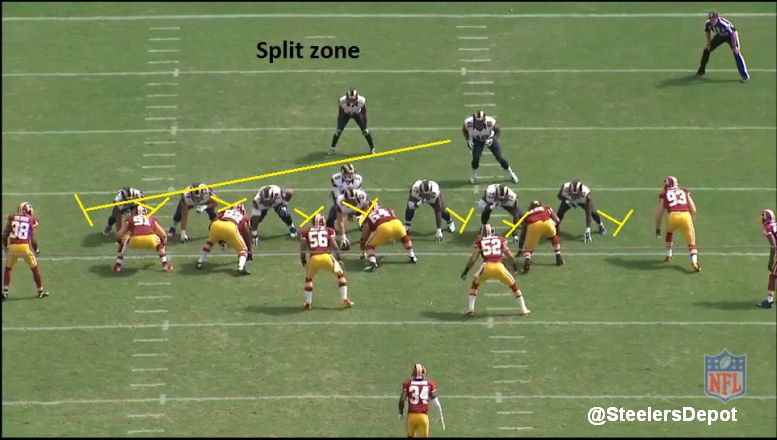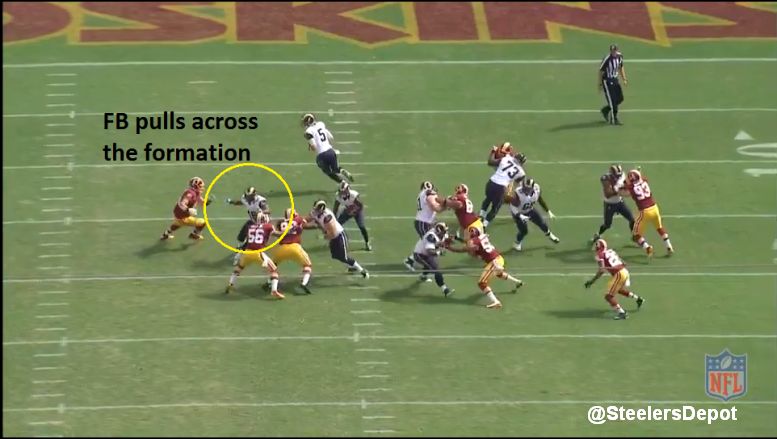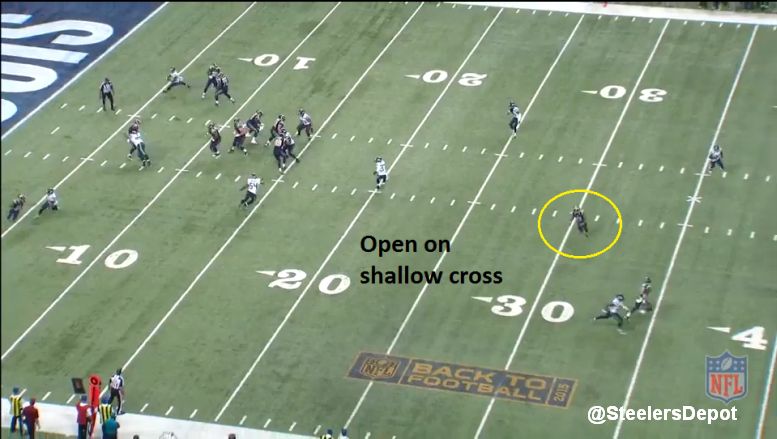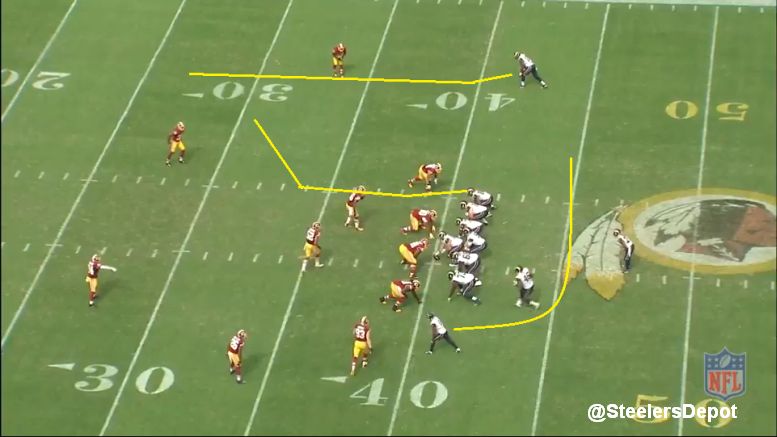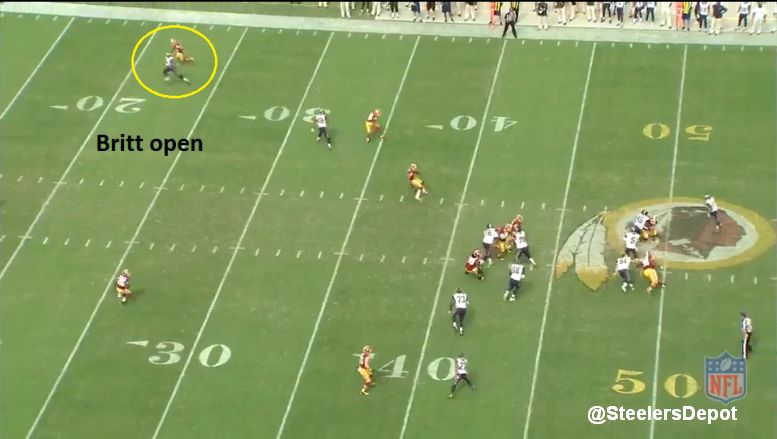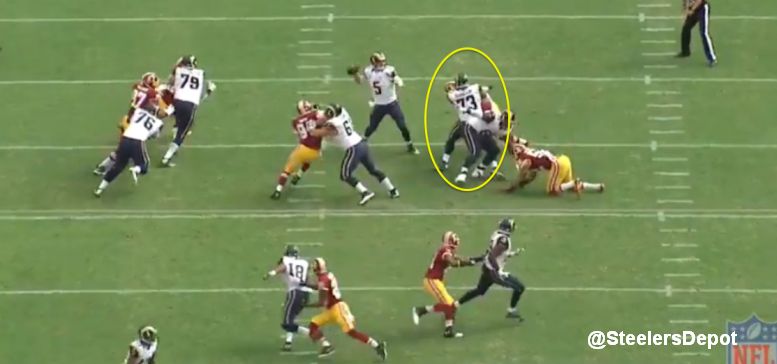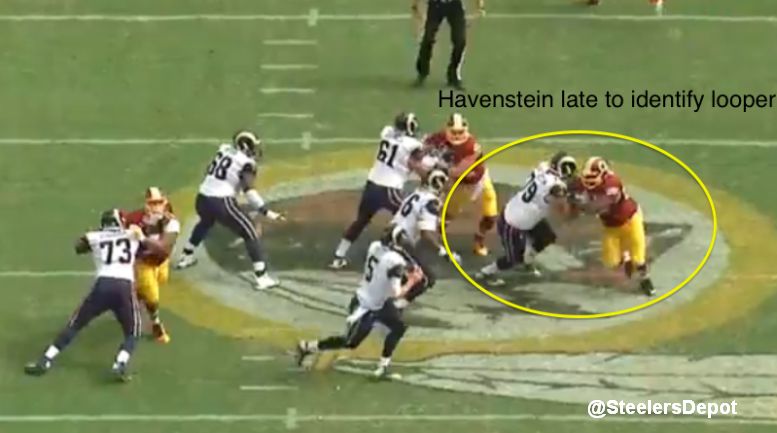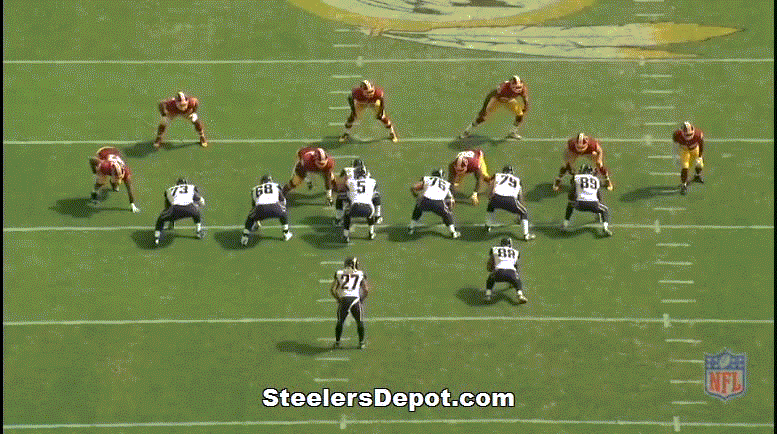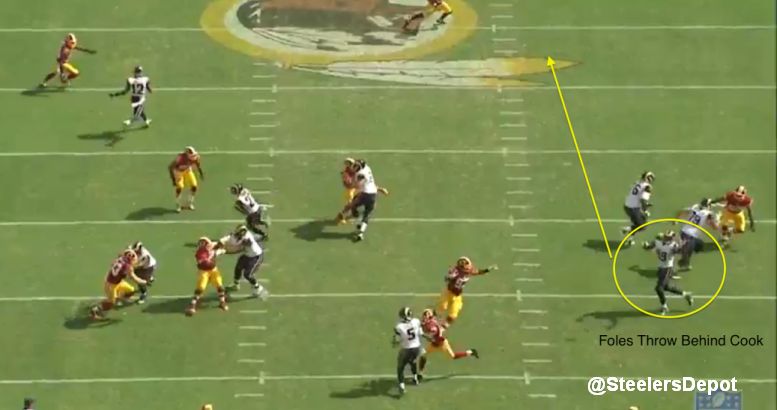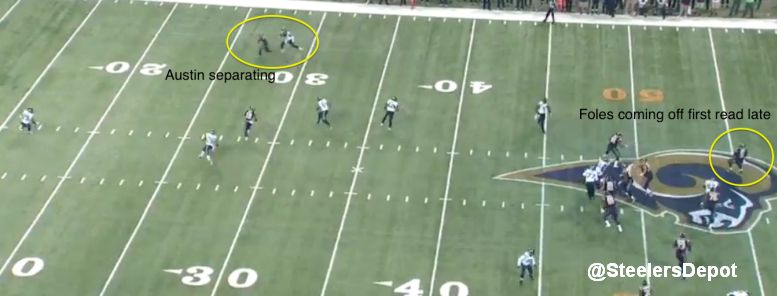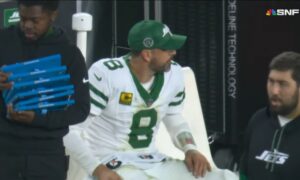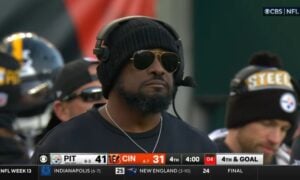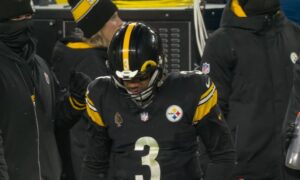This year, Jon Ledyard and I will be collaborating our scouting reports. We’ll play to our strengths – he’ll be focusing on the individuals while I’ll be looking at overall scheme. These reports will be broken down into two articles, one for offense and one for defense.
Our reports for the St. Louis Rams’ offense.
ALEX’S SCHEME REPORT:
St. Louis’ Run Game
They’ve been rotating running backs and may again if Todd Gurley – whose college tape showed him to be the best back in the draft – plays on Sunday. Benny Cunningham leads them with 17 carries but only Tavon Austin has more than 50 yards. The Rams’ running backs have had issue holding onto the football. Tre Mason has a fumble in seven carries and Isaiah Pead lost one in only a handful of touches. That doesn’t even include Nick Foles, who has a lost fumble on the year, too, though he was in the pocket when that occurred, not running.
Austin has been used on end arounds but also as a bondafide running back. Not just a gadget guy.
They have a very basic running scheme. Almost exclusively inside zone, though they run it out of one-back and two-back with H-Back Corey Harkey, which is a little unusual. Teams usually run it out of single back at this level but it gives them that lead blocker/iso option. They run a ton of split zone, often with Harkey coming across the formation.
Quick refresher on split zone. It’s the offensive line zone blocking one direction with a tight end or fullback coming across the formation to block the end man on the line. So if the offensive line zone blocks to the left, the tight end comes across to the right.
You can see it here.
Watched every run in the first two games and the Rams only had a gap scheme, pulling a player, twice. And once they tossed away from the puller. It doesn’t mean it’s easy to defend but it is a simple scheme without many bells and whistles. Stark difference than the sleight-of-hand San Francisco 49ers or the Wham blocking New England Patriots.
Again, sample size is still relatively small but the Rams show a strong left hash tendency. The Rams run the left on 75% of their left hash runs in the first two weeks. Nine of 12. Remember though, with the split zone they run, there’s always the cutback option.
There is less of a tendency on the right hash though running left does dominate them, doing so on 64.3% of their 14 carries.
One other interesting nugget on their hash tendencies. They have eight left hash carries where they showed an offensive strength, a tight end to one side. On those eight, they have run away from the tight end on seven. They had no clear right hash tendency.
With the ball on the left hash, you can get a pretty good idea of where the ball is going. To the left and away from the strength of the formation.
One last thing. The Rams have only run out of a true shotgun, not including pistol runs, once in two games. Makes them pretty predictable. 3rd and 3 out of the gun? Very good chance it’s a pass. Doesn’t tell you everything but every tendency helps build a picture.
St. Louis is starting two rookie offensive lineman. Left guard Jamon Brown and right tackle Rob Havenstein.
St. Louis’ Passing Game
The Rams don’t have a particularly strong passing attack At least, not on paper. They’re not particularly efficient, Foles is completing under 60% of his passes but they’re producing chunk plays. A quarter of their completions have gone for at least 20 yards.
Jared Cook leads the team with three while Kenny Britt and Stedman Bailey each have two despite the latter two having just four overall receptions apiece.
As Mike Tomlin noted in his press conference, they get their running backs involved in the passing game a ton. Cunningham is second on the team with eight receptions. You’ll see a ton of RB screens. I wasn’t able to get a good feel for when it’d happen but the Rams utilized several wheel routes with their back, too. In the times I saw it, down the left sideline.
The Rams do a nice job of using one play to set up another. Primarily with Tavon Austin. They’ll throw a swing to him and then fake it later in the game, throwing a screen backside. They’ll toss an end around to him and then fake it the next, taking a shot deep.
They faked the end around twice in the first two games, going for gains of 29 and 40 yards, the latter for a touchdown. #1 to the end around side always runs a vertical. If there is a receiver to the other side (reduced split is alert to pass), he’ll run a shallow cross. If there isn’t a WR to the other side, and a TE to the #1 vertical side, the tight end will run a corner route. We’ll show both below.
Cook is basically a wide receiver. Often stands up and is split out in the slot or out wide while Lance Kendricks operates as the Y in-line tight end. It will be interesting to see how the Steelers defend him. They were determined to put a safety over Rob Gronkowski in Week One, using a lot of dime personnel, but Cook isn’t that type of threat and frankly, the Week One results weren’t encouraging across the board.
They could roll a safety up to Cook and play single high, maintaining their base defense. That’s just my guess.
St. Louis’ Special Teams
Isaiah Pead is the kick returner though he doesn’t have a return of more than 22 yards on his three chances. Tavon Austin is the starting punt returner and an obvious threat. One of his two returns went for a 75 yard score. On the punt return unit. Janoris Jenkins and Trumaine Johnson, both cornerbacks, are the jammers.
On the kick return unit, the Rams run a 4-2-1-2-2 formation. Bailey is the upback for Austin.
One major alert on special teams. Since 2012, punter/holder Johnny Hekker has attempted a whopping six fakes. One came on a field goal, a 4th and 2 in 2012, and five others on punts.
They were never attempted on longer than 4th and 8 and three came between 4th and 3 and 4th and 4. Three came in the fourth quarter with the Rams trailing. One came on their first series while another occurred with :49 seconds left in the first half and the Rams up seven with the ball on their own ten (gutsy but the fake worked).
Back in 2013, they appeared to have attempted a fake run with the upback. 4th and 8 on their 22 down 16-6 early in the 4th quarter. It did not work, resulting in a five yard loss.
Part of that may be off the look the Rams got and I wasn’t able to investigate that far. But generally speaking, if the Rams are down in the 4th quarter on 4th and 3-5 with the ball around their own 20? Play it safe and anticipate a fake…just in case.
JON’S INDIVIDUAL REPORT:
The Rams offense has struggled to generate a consistent attack in their two games so far this season, but they rose to the occasion in crunch time against Seattle during Week 1. The team couldn’t find similar success in Week 2 against Washington, falling to 1-1 by a score of 24-10. One of the Rams biggest struggles was their inability to run the ball effectively, a much-needed crutch for quarterback Nick Foles to lean on.
The running back situation should receive a boost this week when rookie Todd Gurley is inserted into the lineup for his first NFL action. Tre Mason and Benny Cunningham have been solid fill-ins, but neither offers the combination of speed and power that Gurley brings to the table.
The backfield talent won’t matter much if the offensive line can’t improve their run blocking however. There are strong points, but as a unit with two rookies in the starting lineup and five players who aren’t used to working together, there have been substantial growing pains.
Rookie Jamon Brown has really struggled in his first two NFL games while starting at left guard, often due to his limited athleticism and quickness off the ball.
I billed Brown as a power scheme guy who would have trouble hitting targets in space pre-draft, so it doesn’t surprise me that Brown can’t get to the linebacker at the second level on this play. Because he can’t hit moving targets with regularity, he’ll often lunge in an attempt to make blocks outside his frame, which results in whiffs like this:
That swing-and-a-miss was from Brown’s first NFL drive, during which he false-started on the very next play. He’s powerful when he gets his hands on defenders, but is definitely limited in space.
His linemate Greg Robinson is a much better run blocker than he is a pass protector, where he has a long way to go to develop proper footwork as a left tackle. Doesn’t get his set foot grounded properly and gives up the edge easily as a result.
Opens the gate and allows the defender to win the corner and drill his quarterback. Big no-no, especially with Foles starting from shotgun, where you know he’ll be deep in the pocket.
Robinson’s footwork makes him susceptible to giving up inside pressure as well. Fails to land his punch or move his feet to mirror Michael Bennett’s attack, allowing the defensive end to nail Foles for the sack.
It’s coach-speak, but it is often said that an offensive lineman’s butt should be like a video camera that never stops recording the quarterback in pass protection. Taking a look at both of those images above, someone should fill Robinson in on that bit of wisdom.
Right tackle Rob Havenstein, another rookie, is on the right side of the previous image. He’s in the early process of getting bull-rushed straight back into his quarterback by Cliff Avril, a speed rusher not know for his power. Havenstein’s biggest issue in pass protection is getting leverage consistently, the same struggle he endured in college at 6’7. Like Brown, he’s not great in space, but is a powerful run blocker when he hits his target.
Unfortunately he and right guard have a plethora of issues when it comes to handling stunts up front. Washington ran several simple twists when attacking the right side of the Rams offensive line, but the law firm of Saffold and Havenstein couldn’t pick it up.
Far from the last time they would struggle with the concept either. Both the looper and the crasher get free with ease, as Havenstein actually falls down trying to recover.
Minutes later, a second three-man rush got home on the same twist, but this time just the looper got a free hit on Foles when Havenstein failed to identify him.
Two three-man rushes getting home on your quarterback quickly due to a simple twist involving a nose tackle as the looper? Ugly to say the least.
While the offensive line definitely has a lengthy list of concerns, Foles has proven to be a quandary in and of himself. I’ve often said that Foles is a rhythm quarterback who can succeed within the context of a well-built offense and good protection, but won’t consistently elevate the play of those around him. In short, he’s limited, with average velocity and an inconsistent deep ball. When the situation is just right, Foles can make some nice throws. Ask him to move off his base and reset in the pocket, and he’s pretty much finished.
St. Louis’ current offensive situation doesn’t offer many ideal scenarios for Foles to thrive in.
Mostly clean pocket for Foles, who has time and space to step into his throw, yet zips one behind tight end Jared Cook. Cook should probably still make this catch, but instead of the ball being out in front of him leading him to the sideline, it’s well off-target.
Ball placement/location is a big issue for Foles, and it has caused the Rams offense to miss several opportunities for big plays. Foles missed badly on a wide open screen to Cook in the second quarter against Washington, with plenty of space in front of the tight end for a potential big gain.
If Foles’ accuracy is an issue on short-intermediate routes, the problems down the field are just as substantial. Misses a touchdown pass to Tavon Austin here when he is late with the throw down the right sideline.
Ball should already be in flight when Austin starts to separate from Richard Sherman, but instead Foles waits far too long and ends up under-throwing Austin so badly that Sherman catches up to the pass.
As for Foles’ weapons, there is plenty of talent around him, but not always the soundest execution. Drops are an issue for just about every target, especially Cook and Kenny Britt.
Austin is still an enigma, but has three catches this year and eight rushes. He lines up in the backfield, in the slot, and out wide, often coming across the formation for a pitch or handoff. He’s a gadget guy, but one of the fastest players in the NFL, and I mean top ten fast. Austin’s burst is extremely dangerous in the open field as a returner and as a ball carrier on offense, able to accelerate through the slightest crease in the blink of an eye, destroying defenders’ pursuit angles.
That said, St. Louis has never been able to maximize Austin’s skills, and as a receiver, he’s very much a just-tricks pony (see what I did there?). If Pittsburgh can fly to the ball, his home run desire can be used against him, as Austin will often give ground to attempt to gain more if he thinks he can work out of trouble. If the defenders stay disciplined, the Steelers defense should have no issues keeping Austin hemmed in.
Cook isn’t the Rams only tight end who offers unique athleticism and downfield prowess, as Lance Kendricks has remained a part of the Rams offensive plans since 2011, when the franchise drafted him. Kendricks has always had plenty of ability due to his athleticism and fluidity as a former wide receiver, but like Austin, has never really maximized his skills in St. Louis. Neither Kendricks nor Cook are ideal blockers, but the Rams will often use both players in that capacity, even at fullback.
In short, the Rams offense is about as non-threatening a unit as you can find in the NFL, but has a little splash play ability due to their athleticism and speed down the field. They’ll undoubtedly try to take advantage of the Steelers defensive weakness at safety, particularly with play-action vertical shots, one of their staples. Inside the Steelers 50, look for St. Louis to take a shot on an early down.
On special teams, Austin obviously makes the Rams dangerous as a punt returner, already taking one kick back for a 75-yard touchdown this season. Cunningham typically handles kick return duties, getting vertical with very little hesitation. That said, he doesn’t have game-breaking speed or moves in the open field.
Greg Zuerlein may have the strongest leg of any kicker in the NFL, and is perfect this season on field goals (5/5) and extra points (3/3). The fourth-year pro has only missed one extra point in his NFL career, but can be inaccurate at times on field goals, but is generally considered one of the better kickers in the league.

